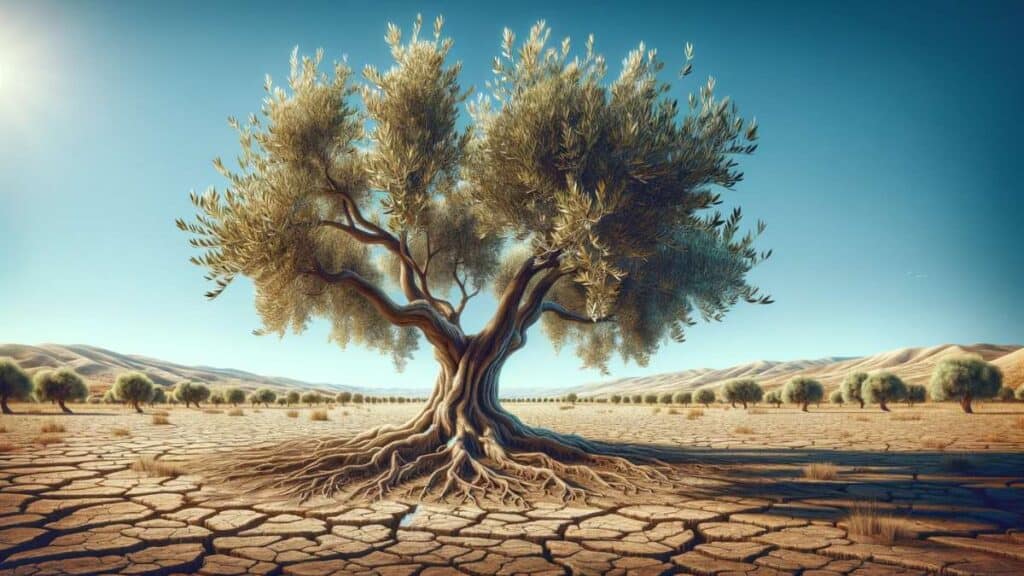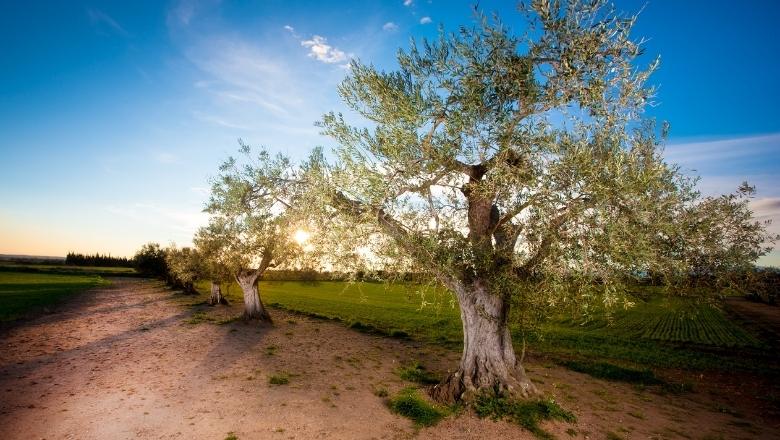Olive Tree Underwatering Symptoms and Fixes
Olive Knowledge is a part of Amazon Associates. As an Amazon Associate, we earn from qualifying purchases. Read our Affiliate Disclosure to learn more.
Even though olive trees are pretty drought-resistant plants, watering olive trees is crucial if you want the best yield and healthy growth. When trees don’t have enough water, they’ll show you some signs of it, and in this post, I’ll show you all the underwatering symptoms and how to fix them.
Key Takeaways:
- Underwatered olive trees show symptoms like curling or wilting leaves, especially brown at tips and edges.
- Discolored, undersized leaves, leaf scorch, and yellowing indicate water shortage.
- Early leaf color change and shedding, regardless of season, suggest insufficient watering.
Signs That Olive Tree Is Underwatered

Here are three signs that your olive tree isn’t getting enough water and that you should consider watering it.
1. Curling or Wilted Leaves
- Examine the leaves on your trees. Your olive tree probably needs more water if you see any signs of withering, curling, or turning brown towards the tips and edges.
2. Color and Size
- Large clusters of discolored and/or undersized leaves are a sign that a tree needs water. Leaf scorch, which resembles sunburn, and yellowing leaves are two indicators that a tree lacks water.
3. Early Transitioning
- In the autumn, leaves begin to change color and finally shed to make way for winter. The premature occurrence of this might be caused by inadequate irrigation of your olive trees. Consider watering your olive tree if you see that your leaves are turning color and falling to the ground early.
- The changeover might occur at the beginning of the year or persist all year long. Your olive tree is clearly underwatered if you observe it losing leaves regularly, regardless of the weather.
Check The Moisture of The Soil
If the olive tree still looks healthy, but you suspect that it lacks water, you can always do some tests to check the soil. Here are two pretty simple steps to check it.
1. Screw Driver Soil Test
- If you want to check if your olive tree is receiving adequate water, you may do a few tests on the soil. The soil underneath your tree should be probed two to three inches with a thin, strong tool (such as a screwdriver). It’s a positive sign that your olive trees are underwatered and require extra water if it’s challenging to do so.
2. Handful Soil Test
- You may also test the soil by holding it in your palm to see if your olive tree needs water or not. Grab a scoop of dirt and examine its condition after digging 5-7 inches beneath your tree. Cool, wet soil is ideal for a well-irrigated tree. Try to form a ball with soil. If it collapses, the tree requires extra water. If the soil around your tree is solid, it may be getting too much water.
3. Use a Soil Moisture Meter
- If you want to get precise measurements, I suggest that you use a soil moisture meter. With it, you’ll be able to get thorough and detailed measurements of the soil, so you’ll know exactly if it requires additional watering.
Fixing an Underwatered Olive Tree

Find out precisely which area of the tree needs water the most before rushing in to start mending it. Naturally, a tree’s roots are buried in the ground, and a tree absorbs water through its roots. However, where precisely should the water go?
Think of the canopy of the trees as an umbrella. The drip line, which is the region right beneath the outside rim of the umbrella, is where the feeder roots, which are tiny and near to the soil, develop. The tree’s anchoring roots are deeper and can go below the drip line. If you’re wondering how to rehydrate a tree, water it in the area around the drip line, making sure to provide enough moisture to reach both the feeder roots and the deeper, bigger roots.
Olive trees still require heavy irrigation at least once a month, despite their resistance to dryness. Every time you water, you should give the tree five minutes of medium-intensity hose time multiplied by the diameter of the tree. For instance, it is recommended to water a tree for 25 minutes if its diameter is 5 inches (12.7 cm).
In addition to using a drip hose to water the tree, you can also drill holes around the drip line that are 24 inches (61 cm) deep and spaced every two feet (61 cm.). Sand should be poured into such holes to establish a direct and durable water conduit that will reach the roots.
Use non-chlorinated water if you can; it’s optimal. That is not an issue if you use well water. However, if you use municipal water, you may get rid of the chlorine by letting the water soak in a container for two hours before using it for irrigation.
How to Properly Water an Olive Tree
Young olive trees should get frequent watering as they grow. If you wish to encourage olive development, be prepared to water your trees sparingly and thoroughly.
- For the first two weeks, water newly planted specimens every third day. Use a drip watering system that is set as close to the root ball as you can.
- Once the initial two weeks have passed, reduce watering to once per week. At this point, relocate the drip emitter so that it is a few inches closer to the trunk.
- After every other week, move the drip emitter a few inches further from the trunk. Once the drip emitter is positioned beneath the drip line of the canopy, stop moving it.
- Keep giving your tree at least 1 inch of water every week for the initial several months.
- After the olive tree has been in its new position for a few months, reduce the amount of water it receives to 1 1/2 inches every two weeks.
- During the late spring and fall, watering to 2 inches every two weeks.
- Watering should be reduced in November to 1/2 inch every two weeks, and then it should be discontinued for the winter.
- In the spring, beginning in March, start watering again.
Final Thoughts
Everyone is aware that any plant can suffer catastrophic effects from overwatering, but it’s equally crucial to prevent underwatering. Due to their propensity to succumb to disease, olive trees are especially vulnerable. Therefore, watering them improperly might cause major damage or even result in tree death.
Whether your tree is rooted in the ground or a pot, underwatering might happen. In essence, the tree’s roots become unable to function when it receives little water, and knowing the warning signals might help you save your lovely olive.
Similar Posts:
